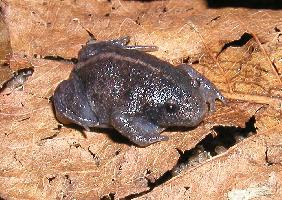
Poids et mesures
| Longueur | 8 cm |
|---|
Description de l'animal
The Mexican burrowing toad (Rhinophrynus dorsalis) is a fascinating and unique species of amphibian that is native to Central America and parts of North America, specifically found from southern Texas in the United States down through Mexico, Guatemala, Honduras, and Nicaragua. This species is the sole member of the family Rhinophrynidae, making it quite distinctive in the world of amphibians.Characterized by its stout body and relatively small size, the Mexican burrowing toad typically measures between 5 to 7.5 centimeters in length. It has a smooth, glossy skin that is predominantly dark brown or reddish-brown in color, which helps it blend into its surroundings. One of the most striking features of this toad is its snout, which is pointed and adapted for burrowing. This adaptation is crucial for its survival, as it spends the majority of its life underground to escape the heat and dryness of its habitat.
The limbs of the Mexican burrowing toad are short and robust, with the hind legs being particularly well-developed for digging. Unlike many other toads, its feet have small, hard tubercles instead of webbing, which aids in burrowing. Its eyes are small and set far apart, and it has a distinctive yellow or orange stripe that runs down the middle of its back, which can vary in brightness and is often used to identify individuals.
Mexican burrowing toads lead a largely fossorial lifestyle, meaning they are adapted to living underground. They are adept at digging and can create burrows several feet deep. They emerge from their burrows primarily at night or after heavy rains, which is also when they feed and breed. Their diet mainly consists of ants and termites, which they catch with their sticky, elongated tongue.
Breeding for these toads occurs in temporary pools formed by rainwater. Remarkably, their entire breeding process, from mating to tadpole development, is rapid, often completed within a few weeks. This rapid lifecycle is an adaptation to their arid environments, where standing water is a fleeting resource. The males emit a unique, low-pitched call to attract females, which sounds more like a hum than the typical croak associated with toads.
The conservation status of the Mexican burrowing toad is currently listed as Least Concern by the IUCN Red List, indicating that it is not at immediate risk of extinction. However, like many amphibians, it faces threats from habitat destruction, pollution, and climate change. Its reliance on temporary pools for breeding makes it particularly vulnerable to changes in precipitation patterns and water availability.
In summary, the Mexican burrowing toad is a remarkable creature, adapted to a subterranean lifestyle in arid environments. Its unique physical characteristics, behavior, and life cycle make it a subject of interest for herpetologists and nature enthusiasts alike. Despite its resilience, the continued preservation of its habitat is crucial for its survival in the face of environmental challenges.
Carte de répartition

Nouvelles photos d'animaux
Top 10 des animaux
- Dolphin gull (Leucophaeus scoresbii)
- Japanese macaque (Macaca fuscata)
- Stone loach (Barbatula barbatula)
- Greek tortoise (Testudo graeca)
- Russian tortoise (Testudo horsfieldii)
- Galápagos tortoise (Geochelone nigra complex)
- Diana monkey (Cercopithecus diana)
- Moustached guenon (Cercopithecus cephus)
- Common flying dragon (Draco volans)
- Galápagos penguin (Spheniscus mendiculus)